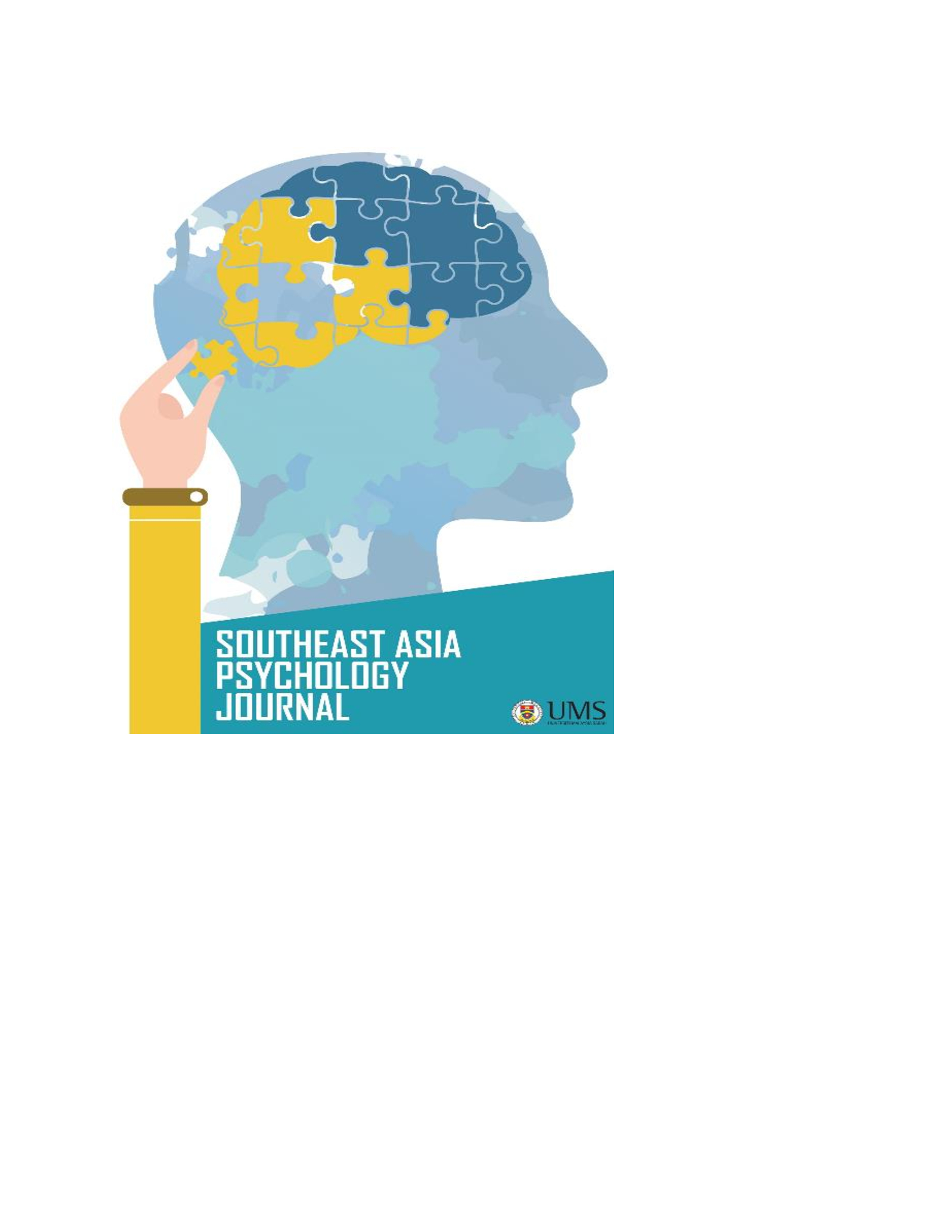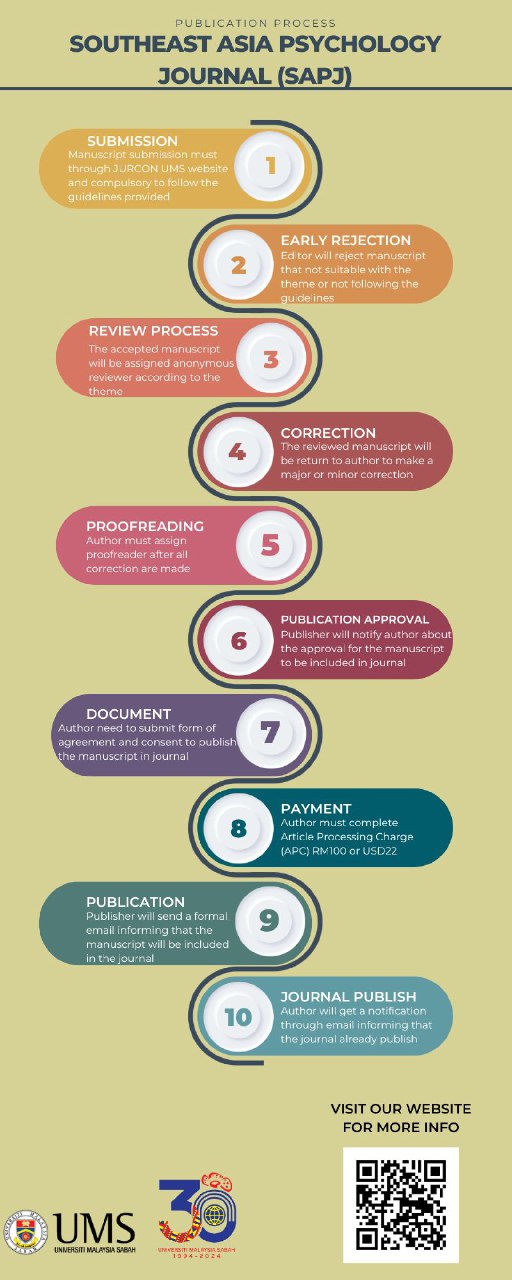BODY DISSATISFACTION, SOCIAL APPEARANCE ANXIETY AND SELF-OBJECTIFICATION: A NARRATIVE REVIEW OF DISORDERED EATING
DOI:
https://doi.org/10.51200/sapj.v10i2.4930Keywords:
Body Image; Body Dissatisfaction; Ideals of Thinness; Self-Objectification; Eating Disorders; AnxietyAbstract
Humans form opinions about their bodies at a very early age, and children as young as 3 years old displayed body confidence issues. The likelihood of experiencing body dissatisfaction increases across childhood and into adolescence. Body mass index (BMI) is an important predictor of body dissatisfaction, and BMI is associated with body satisfaction across cultures. Studies on disordered eating and body dissatisfaction were predominantly conducted in Western countries. However, several recent studies suggested that women in Asian countries were vulnerable to disordered eating, similar to their Western counterparts. In Malaysia, negative body image perceptions, weight obsession and disordered eating were usually identified in adolescents with peer and emotional problems. Having a negative body image is associated with social appearance anxiety. The fear of evaluation by oneself and others is often associated with body image disturbance which is a key risk factor for the development of eating disorder symptoms among adolescents. Social appearance anxiety and eating disorders are highly comorbid. Women diagnosed with an eating disorder tend to have higher levels of BMI, drive for thinness, and body dissatisfaction. Objectification theory could explain the relationship between body image dissatisfaction and disordered eating. Objectification theory has linked self-objectification to negative emotional experiences and disordered eating behaviour in cultures that sexually objectify the female body. High levels of disordered eating attitudes and behaviours are often associated with greater objectification of their bodies.
References
Almas, I., Khan, Y., Hassan, T., Maqbool, F., Ali, N., & Khalid, T. (n.d.). Dilemma of Body Image & Bullying: Experience of Teenagers Girls. http://www.webology.org
As, Z., Basri R, M., & Ce, H. (n.d.). An Evaluation of Eating Behavior, Psychosocial Status and Body Mass Index among Adolescents in Malaysia.
Ball, K., & Lee, C. (2002). Psychological stress, coping, and symptoms of disordered eating in a community sample of young Australian women. International Journal of Eating Disorders, 31(1), 71–81. https://doi.org/10.1002/eat.1113
Barry, D. T., Grilo, C. M., & Masheb, R. M. (2002). Gender differences in patients with binge eating disorder. International Journal of Eating Disorders, 31(1), 63–70. https://doi.org/10.1002/eat.1112
Bashir Shaikh, F., Rehman, M., & Amin, A. (2020). Cyberbullying: A Systematic Literature Review to Identify the Factors Impelling University Students Towards Cyberbullying. IEEE Access, 8, 148031–148051. https://doi.org/10.1109/ACCESS.2020.3015669
Bauman, S., Toomey, R. B., & Walker, J. L. (2013). Associations among bullying, cyberbullying, and suicide in high school students. Journal of Adolescence, 36(2), 341–350. https://doi.org/10.1016/j.adolescence.2012.12.001
Berne, S., Frisén, A., & Kling, J. (2014). Appearance-related cyberbullying: A qualitative investigation of characteristics, content, reasons, and effects. Body Image, 11(4), 527–533. https://doi.org/10.1016/j.bodyim.2014.08.006
Brosof, L. C., & Levinson, C. A. (2017). Social appearance anxiety and dietary restraint as mediators between perfectionism and binge eating: A six month three wave longitudinal study. Appetite, 108, 335–342. https://doi.org/10.1016/j.appet.2016.10.015
Buğra Karaman, H., & Professor, F. (2020). AN INVESTIGATION OF ADOLESCENTS’ LEVELS OF EXPOSURE TO CYBERBULLYING IN TERMS OF SOCIAL MEDIA ATTITUDES AND SOCIAL APPEARANCE ANXIETY Coşkun Arslan PhD. In Psycho-Educational Research Reviews | (Vol. 9, Issue 3). London Academic Publishing. https://www.journals.lapub.co.uk/index.php/PERR
Calogero, R. M., Davis, W. N., & Thompson, J. K. (2005). The Role of Self-Objectification in the Experience of Women with Eating Disorders. Sex Roles, 52(1–2), 43–50. https://doi.org/10.1007/s11199-005-1192-9
Carvalho, M., Branquinho, C., & de Matos, M. G. (2021). Cyberbullying and Bullying: Impact on Psychological Symptoms and Well-Being. Child Indicators Research, 14(1), 435–452. https://doi.org/10.1007/s12187-020-09756-2
Cheah, W. L., Hazmi, H., & Chang, C. T. (2017). Disordered eating and body image issues and their associated factors among adolescents in urban secondary schools in Sarawak, Malaysia. International Journal of Adolescent Medicine and Health, 29(2). https://doi.org/10.1515/ijamh-2015-0044
Chen, J., Guo, L., Gu, L., & Han, H. (2021). The introduction of treatment and the cultural adaptability of western psychotherapies for eating disorders in China. International Journal of Eating Disorders, 54(1), 102–106. https://doi.org/10.1002/eat.23437
Cho, A., & Lee, J.-H. (2013). Body dissatisfaction levels and gender differences in attentional biases toward idealized bodies. Body Image, 10(1), 95–102. https://doi.org/10.1016/j.bodyim.2012.09.005
Chong, L. S., Chin, Y. S., Gan, W. Y., & Mohd Nasir, M. T. (2017). Associations between socio-demographic characteristics and pubertal status with disordered eating among primary school children in Selangor, Malaysia. Asia Pacific Journal of Clinical Nutrition , 326–333.
Claes, L., Hart, T. A., Smits, D., van den Eynde, F., Mueller, A., & Mitchell, J. E. (2012). Validation of the Social Appearance Anxiety Scale in Female Eating Disorder Patients. European Eating Disorders Review, 20(5), 406–409. https://doi.org/10.1002/erv.1147
Coles, M. E., Phillips, K. A., Menard, W., Pagano, M. E., Fay, C., Weisberg, R. B., & Stout, R. L. (2006). Body dysmorphic disorder and social phobia: cross-sectional and prospective data. Depression and Anxiety, 23(1), 26–33. https://doi.org/10.1002/da.20132
Conley, A., & Boardman, J. D. (2007). Weight overestimation as an indicator of disordered eating behaviors among young women in the United States. International Journal of Eating Disorders, 40(5), 441–445. https://doi.org/10.1002/eat.20383
Fink, E., Bodell, L., Smith, A., & Joiner, T. (2013). The Joint Influence of Disordered Eating and Anxiety Sensitivity on the Acquired Capability for Suicide. Cognitive Therapy and Research, 37(5), 934–940. https://doi.org/10.1007/s10608-012-9502-3
Fitriyah, L., & Rokhmawan, T. (2019). “You’re fat and not normal!” From Body Image to Decision of Suicide. Indonesian Journal of Learning Education and Counseling, 1(2), 102–118. https://doi.org/10.31960/ijolec.v1i2.75
Fontenelle, L. F., Vı́tor Mendlowicz, M., de Menezes, G. B., Papelbaum, M., Freitas, S. R., Godoy-Matos, A., Coutinho, W., & Appolinário, J. C. (2003). Psychiatric comorbidity in a Brazilian sample of patients with binge-eating disorder. Psychiatry Research, 119(1–2), 189–194. https://doi.org/10.1016/S0165-1781(03)00127-6
Frisén, A., & Berne, S. (2020). Swedish adolescents’ experiences of cybervictimization and body‐related concerns. Scandinavian Journal of Psychology, 61(1), 68–76. https://doi.org/10.1111/sjop.12561
Gadalla, T. M. (2008). Psychiatric comorbidity in eating disorders: a comparison of men and women. Journal of Men’s Health, 5(3), 209–217. https://doi.org/10.1016/j.jomh.2008.06.033
Gan, W., Mohamad, N., & Law, L. (2018). Factors Associated with Binge Eating Behavior among Malaysian Adolescents. Nutrients, 10(1), 66. https://doi.org/10.3390/nu10010066
Gardner, B., Cane, J., Rumsey, N., & Michie, S. (2012). Behaviour change among overweight and socially disadvantaged adults: A longitudinal study of the NHS Health Trainer Service. Psychology & Health, 27(10), 1178–1193. https://doi.org/10.1080/08870446.2011.652112
Gatward, N. (2007). Anorexia nervosa: an evolutionary puzzle. European Eating Disorders Review, 15(1), 1–12. https://doi.org/10.1002/erv.718
Grabe, S., Ward, L. M., & Hyde, J. S. (2008). The role of the media in body image concerns among women: A meta-analysis of experimental and correlational studies. Psychological Bulletin, 134(3), 460–476. https://doi.org/10.1037/0033-2909.134.3.460
Greenwood, D. N. (n.d.). Chrisler, Handbook of Gender Research in Psychology Vol 2 (2010). Lippman, J.R. .
Griffin, Y. M. (2021). HOW DO I LOOK? AN EMPIRICAL INVESTIGATION OF SELF-OBJECTIFICATION AND MUSCLE DYSMORPHIA AMONG FEMALE BODYBUILDERS AND FEMALE RECREATIONAL LIFTERS.
Hart, T. A., Flora, D. B., Palyo, S. A., Fresco, D. M., Holle, C., & Heimberg, R. G. (2008). Development and Examination of the Social Appearance Anxiety Scale. Assessment, 15(1), 48–59. https://doi.org/10.1177/1073191107306673
Holland, G., & Tiggemann, M. (2016). A systematic review of the impact of the use of social networking sites on body image and disordered eating outcomes. Body Image, 17, 100–110. https://doi.org/10.1016/j.bodyim.2016.02.008
Homan, K., McHugh, E., Wells, D., Watson, C., & King, C. (2012). The effect of viewing ultra-fit images on college women’s body dissatisfaction. Body Image, 9(1), 50–56. https://doi.org/10.1016/j.bodyim.2011.07.006
Honkalampi, K., Hintikka, J., Tanskanen, A., Lehtonen, J., & Viinamäki, H. (2000). Depression is strongly associated with alexithymia in the general population. Journal of Psychosomatic Research, 48(1), 99–104. https://doi.org/10.1016/S0022-3999(99)00083-5
Janssen, I., Craig, W. M., Boyce, W. F., & Pickett, W. (2004). Associations Between Overweight and Obesity With Bullying Behaviors in School-Aged Children. Pediatrics, 113(5), 1187–1194. https://doi.org/10.1542/peds.113.5.1187
Jung, J., & Forbes, G. B. (2006). Multidimensional Assessment of Body Dissatisfaction and Disordered Eating in Korean and US College Women: A Comparative Study. Sex Roles, 55(1–2), 39–50. https://doi.org/10.1007/s11199-006-9058-3
Jung, J., Forbes, G. B., & Lee, Y. (2009). Body Dissatisfaction and Disordered Eating Among Early Adolescents From Korea and the US. Sex Roles, 61(1–2), 42–54. https://doi.org/10.1007/s11199-009-9609-5
Khor, G. L., Zalilah, M. S., Phan, Y. Y., Ang, M., Maznah, B., & Norimah, A. K. (2009). Perceptions of Body Image among Malaysian Male and Female Adolescents. In Singapore Med J (Vol. 50, Issue 3). https://www.researchgate.net/publication/24263489
Kim, H. M. (2021). What do others’ reactions to body posting on Instagram tell us? The effects of social media comments on viewers’ body image perception. New Media & Society, 23(12), 3448–3465. https://doi.org/10.1177/1461444820956368
Koskina, A., van den Eynde, F., Meisel, S., Campbell, I. C., & Schmidt, U. (2011). Social appearance anxiety and bulimia nervosa. Eating and Weight Disorders - Studies on Anorexia, Bulimia and Obesity, 16(2), 142–145. https://doi.org/10.1007/BF03325321
Lee, B., Jeong, S., & Roh, M. (2018). Association between body mass index and health outcomes among adolescents: the mediating role of traditional and cyber bullying victimization. BMC Public Health, 18(1), 674. https://doi.org/10.1186/s12889-018-5390-0
Levinson, C. A., & Rodebaugh, T. L. (2012). Social anxiety and eating disorder comorbidity: The role of negative social evaluation fears. Eating Behaviors, 13(1), 27–35. https://doi.org/10.1016/j.eatbeh.2011.11.006
Levinson, C. A., Rodebaugh, T. L., White, E. K., Menatti, A. R., Weeks, J. W., Iacovino, J. M., & Warren, C. S. (2013). Social appearance anxiety, perfectionism, and fear of negative evaluation. Distinct or shared risk factors for social anxiety and eating disorders? Appetite, 67, 125–133. https://doi.org/10.1016/j.appet.2013.04.002
Liechty, J. M., & Lee, M.-J. (2013). Longitudinal predictors of dieting and disordered eating among young adults in the U.S. International Journal of Eating Disorders, 46(8), 790–800. https://doi.org/10.1002/eat.22174
Malinowska-Cieślik, M., Dzielska, A., & Oblacińska, A. (2022). Psychosocial Determinants of Adolescents’ Cyberbullying Involvement—The Role of Body Satisfaction. International Journal of Environmental Research and Public Health, 19(3), 1292. https://doi.org/10.3390/ijerph19031292
Mamun, A. A., O’Callaghan, M. J., Williams, G. M., & Najman, J. M. (2013). Adolescents bullying and young adults body mass index and obesity: a longitudinal study. International Journal of Obesity, 37(8), 1140–1146. https://doi.org/10.1038/ijo.2012.182
Mazubir, N. N., Hassan, N. M., Abd Aziz, A., & Suan, W. B. (2020). Disordered Eating Behaviour among School-going Adolescents: Prevalence and Associated Factors. International Journal of Academic Research in Progressive Education and Development, 9(1), 193–207. https://doi.org/10.6007/IJARPED/v9-i1/6987
Mellor, D., Ricciardelli, L. A., McCabe, M. P., Yeow, J., bt Mamat, N. H., & bt Mohd Hapidzal, N. F. (2010). Psychosocial Correlates of Body Image and Body Change Behaviors Among Malaysian Adolescent Boys and Girls. Sex Roles, 63(5–6), 386–398. https://doi.org/10.1007/s11199-010-9812-4
Menzel, J. E., Schaefer, L. M., Burke, N. L., Mayhew, L. L., Brannick, M. T., & Thompson, J. K. (2010). Appearance-related teasing, body dissatisfaction, and disordered eating: A meta-analysis. Body Image, 7(4), 261–270. https://doi.org/10.1016/j.bodyim.2010.05.004
Mervat Nasser, & Helen Malson. (2009). Beyond western disorders: Thinness and self-starvation of other-ed women (1st ed.). Routledge.
Mustafa, M. S. A., Mahat, I. R., Md Shah, M. A. M., Mohd. Ali, N. A., Mohideen, R. S., & Mahzan, S. (2022). The Awareness of the Impact of Body Shaming among Youth. International Journal of Academic Research in Business and Social Sciences, 12(4). https://doi.org/10.6007/IJARBSS/v12-i4/13197
Myers, T. A., & Crowther, J. H. (2009). Social comparison as a predictor of body dissatisfaction: A meta-analytic review. Journal of Abnormal Psychology, 118(4), 683–698. https://doi.org/10.1037/a0016763
Omar, A., & Che Bakar, O. (2008). Bio-psychological perspectives of eating disorders and obesity: a revisited. ASEAN Journal of Psychiatry , 33–41.
Patchin, J. W., & Hinduja, S. (2010). Cyberbullying and Self-Esteem*. Journal of School Health, 80(12), 614–621. https://doi.org/10.1111/j.1746-1561.2010.00548.x
Peat, C. M., & Muehlenkamp, J. J. (2011). Self-Objectification, Disordered Eating, and Depression. Psychology of Women Quarterly, 35(3), 441–450. https://doi.org/10.1177/0361684311400389
Radwan, H., Hasan, H. A., Ismat, H., Hakim, H., Khalid, H., Al-Fityani, L., Mohammed, R., & Ayman, A. (2019). Body Mass Index Perception, Body Image Dissatisfaction and Their Relations with Weight-Related Behaviors among University Students. International Journal of Environmental Research and Public Health, 16(9), 1541. https://doi.org/10.3390/ijerph16091541
Rodgers, R. F., & Melioli, T. (2016). The Relationship Between Body Image Concerns, Eating Disorders and Internet Use, Part I: A Review of Empirical Support. Adolescent Research Review, 1(2), 95–119. https://doi.org/10.1007/s40894-015-0016-6
Schaefer, L. M., & Thompson, J. K. (2018). Self-objectification and disordered eating: A meta-analysis. International Journal of Eating Disorders, 51(6), 483–502. https://doi.org/10.1002/eat.22854
Schreurs, L., & Vandenbosch, L. (2022). Different interactions with appearance-focused social media content and adolescents’ body dissatisfaction: A within-person perspective. Computers in Human Behavior, 135, 107364. https://doi.org/10.1016/j.chb.2022.107364
Selkie, E. M., Kota, R., Chan, Y.-F., & Moreno, M. (2015). Cyberbullying, Depression, and Problem Alcohol Use in Female College Students: A Multisite Study. Cyberpsychology, Behavior, and Social Networking, 18(2), 79–86. https://doi.org/10.1089/cyber.2014.0371
Sim, L., & Zeman, J. (2004). Emotion Awareness and Identification Skills in Adolescent Girls With Bulimia Nervosa. Journal of Clinical Child & Adolescent Psychology, 33(4), 760–771. https://doi.org/10.1207/s15374424jccp3304_11
Singh, M., Shamshir, D., & Dhillon, S. (2020). Prevalence and Influence of Cyberbullying Behaviour on Self-Esteem and Body Image among the Adolescents. In Wesleyan Journal of Research (Vol. 13, Issue 25). https://www.researchgate.net/publication/347813478
Slater, A., & Tiggemann, M. (2002). A Test of Objectification Theory in Adolescent Girls. Sex Roles, 46(9/10), 343–349. https://doi.org/10.1023/A:1020232714705
Soo, K. L., Shariff, Z. M., Taib, M. N. M., & Samah, B. A. (2008). Eating Behaviour, Body Image, and Self-Esteem of Adolescent Girls in Malaysia. Perceptual and Motor Skills, 106(3), 833–844. https://doi.org/10.2466/pms.106.3.833-844
Sorensen, C. (n.d.). Exploring Associations Between Social Appearance Anxiety, External Shame and Body Dissatisfaction.
Spoor, S. T. P., Bekker, M. H. J., van Heck, G. L., Croon, M. A., & van Strien, T. (2005). Inner Body and Outward Appearance: The Relationships Between Appearance Orientation, Eating Disorder Symptoms, and Internal Body Awareness. Eating Disorders, 13(5), 479–490. https://doi.org/10.1080/10640260500297267
Stice, E. (2002). Risk and maintenance factors for eating pathology: A meta-analytic review. Psychological Bulletin, 128(5), 825–848. https://doi.org/10.1037/0033-2909.128.5.825
Strahan, E. J., Wilson, A. E., Cressman, K. E., & Buote, V. M. (2006). Comparing to perfection: How cultural norms for appearance affect social comparisons and self-image. Body Image, 3(3), 211–227. https://doi.org/10.1016/j.bodyim.2006.07.004
Tajik, E., Latiffah, A. L., Awang, H., Siti Nur’Asyura, A., Chin, Y. S., Azrin Shah, A. B., Patricia Koh, C. H., & Mohd Izudin Hariz, C. G. (2016). Unhealthy diet practice and symptoms of stress and depression among adolescents in Pasir Gudang, Malaysia. Obesity Research & Clinical Practice, 10(2), 114–123. https://doi.org/10.1016/j.orcp.2015.06.001
Tiggemann, M. (2001). The Impact of Adolescent Girls’ Life Concerns and Leisure Activities on Body Dissatisfaction, Disordered Eating, and Self-Esteem. The Journal of Genetic Psychology, 162(2), 133–142. https://doi.org/10.1080/00221320109597955
Tiggemann, M., & Kuring, J. K. (2004). The role of body objectification in disordered eating and depressed mood. British Journal of Clinical Psychology, 43(3), 299–311. https://doi.org/10.1348/0144665031752925
Tiggemann, M., & Lynch, J. E. (2001). Body image across the life span in adult women: The role of self-objectification. Developmental Psychology, 37(2), 243–253. https://doi.org/10.1037/0012-1649.37.2.243
Tiggemann, M., & McGill, B. (2004). The Role of Social Comparison in the Effect of Magazine Advertisements on Women’s Mood and Body Dissatisfaction. Journal of Social and Clinical Psychology, 23(1), 23–44. https://doi.org/10.1521/jscp.23.1.23.26991
Titchener, K., & Wong, Q. J. J. (2015). A weighty issue: Explaining the association between body mass index and appearance-based social anxiety. Eating Behaviors, 16, 13–16. https://doi.org/10.1016/j.eatbeh.2014.10.005
Turel, T., Jameson, M., Gitimu, P., Rowlands, Z., Mincher, J., & Pohle-Krauza, R. (2018). Disordered eating: Influence of body image, sociocultural attitudes, appearance anxiety and depression - a focus on college males and a gender comparison. Cogent Psychology, 5(1), 1483062. https://doi.org/10.1080/23311908.2018.1483062
Tylka, T. L., & Hill, M. S. (2004). Objectification Theory as It Relates to Disordered Eating Among College Women. Sex Roles, 51(11–12), 719–730. https://doi.org/10.1007/s11199-004-0721-2
van Geel, M., Vedder, P., & Tanilon, J. (2014). Relationship Between Peer Victimization, Cyberbullying, and Suicide in Children and Adolescents. JAMA Pediatrics, 168(5), 435. https://doi.org/10.1001/jamapediatrics.2013.4143
Webb, H. J., & Zimmer-Gembeck, M. J. (2014). The Role of Friends and Peers in Adolescent Body Dissatisfaction: A Review and Critique of 15 Years of Research. Journal of Research on Adolescence, 24(4), 564–590. https://doi.org/10.1111/jora.12084
Xu, J.-M., Jun, K.-S., Zhu, X., & Bellmore, A. (n.d.). Learning from Bullying Traces in Social Media.
Xu, X., Mellor, D., Kiehne, M., Ricciardelli, L. A., McCabe, M. P., & Xu, Y. (2010). Body dissatisfaction, engagement in body change behaviors and sociocultural influences on body image among Chinese adolescents. Body Image, 7(2), 156–164. https://doi.org/10.1016/j.bodyim.2009.11.003








